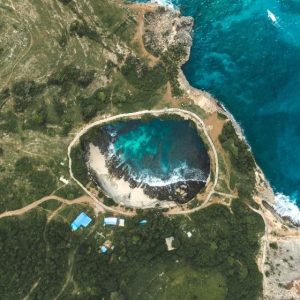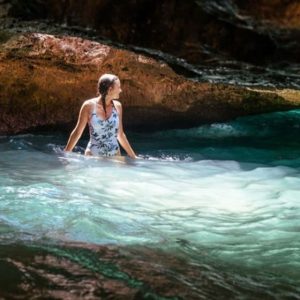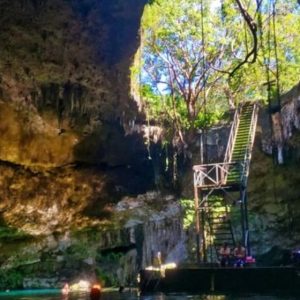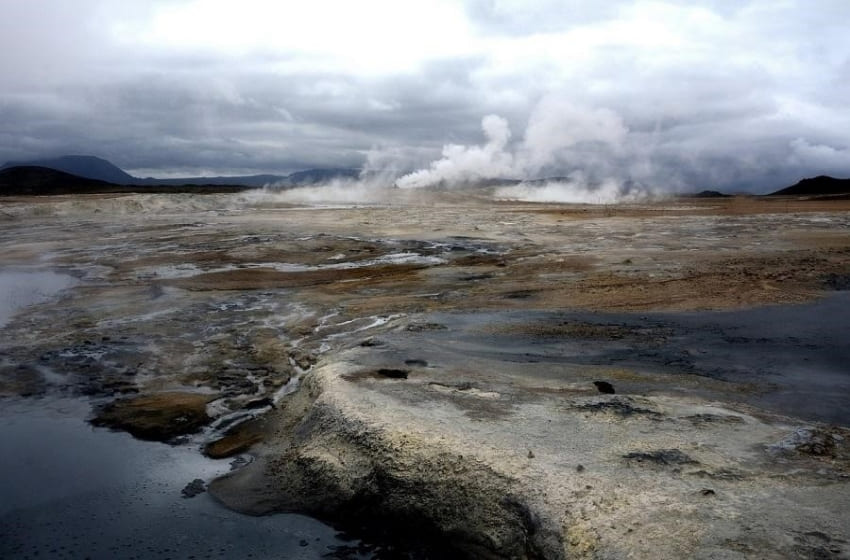
Welcome to the extraordinary realm of Reykjadalur Hot Springs, a natural treasure nestled in Iceland’s picturesque landscape. In this article, we’ll embark on a journey of discovery, combining science, adventure, and relaxation to unravel the mysteries of this geothermal wonder. Picture yourself in the midst of Iceland’s rugged beauty, surrounded by ethereal steam rising from the Earth. Here, you’ll find a warm stream inviting you to take a dip. But before we dive in, let’s uncover the fascinating science behind this captivating phenomenon.
Reykjadalur, meaning “Steam Valley,” is a geological marvel located near the town of Hveragerði in beautiful Iceland. Here, a warm and mineral-rich stream and myriad pools result from the geothermal activity occurring within the Earth’s belly. The magic happens when water seeps into the crust, meeting searing hot magma and resulting in all these wondrous beckoning bodies of water.
But Reykjadalur is not just a natural Jacuzzi; it’s a therapeutic retreat. Its secret lies in the water’s mineral composition, boasting minerals like silica and sulfur. Many believe these minerals to have healing properties, making the springs a haven for skin ailments and relaxation. Beyond the stunning vistas and serene waters, Reykjadalur offers a profound connection to Earth’s natural processes, making it an unmissable destination. As we journey ahead, we’ll delve into the practical aspects of planning your visit, ensuring your safety, and respecting this delicate ecosystem.
About Reykjadalur Hot Springs
Reykjadalur Hot Springs offers a delightful 3-kilometer hike with numerous obligatory photo stops. The trail is quite manageable, making it accessible for most hikers. You’ll meander through stunning landscapes, and the elevation gain is moderate, so you won’t feel like you’re climbing a mountain.
It’s more of a leisurely stroll with a rewarding finale: the soothing hot springs. Whether you’re a seasoned hiker or just looking for a scenic adventure, Reykjadalur’s trail won’t disappoint. So, don’t forget your hiking boots, and get ready for a fantastic geothermal experience!
Let’s Go to Reykjadalur Hot Springs
This geothermal gem rests in the southwestern region of Iceland. Located just a short drive, roughly 45 minutes to an hour, from Iceland’s vibrant capital city, Reykjavik, this natural wonder is easily accessible to visitors. Reykjadalur lies near the charming town of Hveragerði, renowned for its geothermal activity and lush greenhouses. Its proximity to Reykjavik makes it a highly sought-after destination for day trips, allowing you to immerse in the enchanting hot springs while surrounded by Iceland’s surreal and breathtaking landscapes.
Reaching Reykjadalur from Reykjavik is a breeze, making it an excellent option for a day trip. As you set off from Reykjavik, the lively capital of Iceland, you’ll find yourself surrounded by the stunning natural landscapes of the country’s countryside in just a few minutes. Reykjadalur’s proximity to the capital and Hveragerði greatly contributes to the appeal of this journey.
Available Transportation Options
When planning a visit to Reykjadalur Hot Springs, choosing the right transportation method can significantly impact your experience. There are three primary transportation options: renting a car, taking a bus, and joining guided tours. Each option offers a distinct way to reach this geothermal wonder, allowing you to tailor your journey to your preferences and needs. Whether you seek flexibility, local insights, or convenience, understanding these transportation choices is key to making the most of your Reykjadalur adventure.
1) Renting a Car
If you love flexibility and adventure, renting a car is a top choice. You can rent one at Keflavik International Airport or in Reykjavik. From there, it’s a scenic drive to Reykjadalur. Also, having your wheels means you can explore the beautiful locales at your own pace.
To get to Reykjadalur Hot Springs from Keflavik International Airport or Reykjavik, follow Route 1 (Ring Road) east towards Hveragerði, approximately 30 kilometers. Once in Hveragerði, turn right onto Route 39 and ride for about 6 kilometers to reach Reykjadalur.
2) Taking a Bus
If you prefer a more guided experience or simply don’t want to drive, you can board a public bus from Mjodd Bus Station in Reykjavik to Hveragerði, the town closest to Reykjadalur. From Hveragerði, you’ll start your hike to the hot springs. Remember to check the bus schedules prior and plan your trip accordingly.
3) Guided Tour
Do you need a hassle-free way to explore Reykjadalur? Consider joining a guided tour. Many tour operators in Reykjavik offer day trips to this location, complete with transportation to and from the hot springs. Not only does this eliminate the need to navigate, but it also often includes insights and information about the area from experienced guides.
Getting to Reykjadalur is a straightforward and enjoyable part of the adventure. Whether you opt for a self-driven journey, a bus ride, or a guided tour, the wonders of Reykjadalur await you, just a stone’s throw away from Reykjavik’s vibrant energy.
Hiking to a Heavenly Location
Hiking to Reykjadalur Hot Springs is more than just a physical journey; it’s an immersive experience in the heart of Iceland’s natural beauty. As you embark on this adventure, you’ll traverse a scenic trail, embrace the rhythms of nature, and prepare to soak in the rejuvenating hot springs. Take the below aspects in mind to prepare accordingly for your Reykjadalur hike.
Description of the Hiking Trail
I would say that the beginning of the trail is the steepest part you’ll experience in this hike. That said, the Reykjadalur hiking trail is a mesmerizing path that winds through Iceland’s diverse landscapes. It leads you through mossy lava fields, lush green valleys, and captivating mountain capes. Wooden boardwalks ensure minimal environmental impact, guiding you across bubbling streams and meandering brooks. During your journey, the subtle scent of sulfur hints at the geothermal wonders that await, creating a visually stunning and spiritually uplifting trail.
Estimated Hiking Time
Expect to spend approximately 1 to 1.5 hours each way on the Reykjadalur hiking trail. However, this is more than just a time estimate; it’s an invitation to slow down, savor the journey, and relish each moment of your hike. The captivating surroundings and stock grazing on hillsides may lead you to pause for photos, admire the ever-changing vistas, or simply immerse yourself in the serenity of Reykjadalur’s untouched terrain. Though the terrain is not marked, it’s clearly visible and kempt, as you can see it all through without confusion. 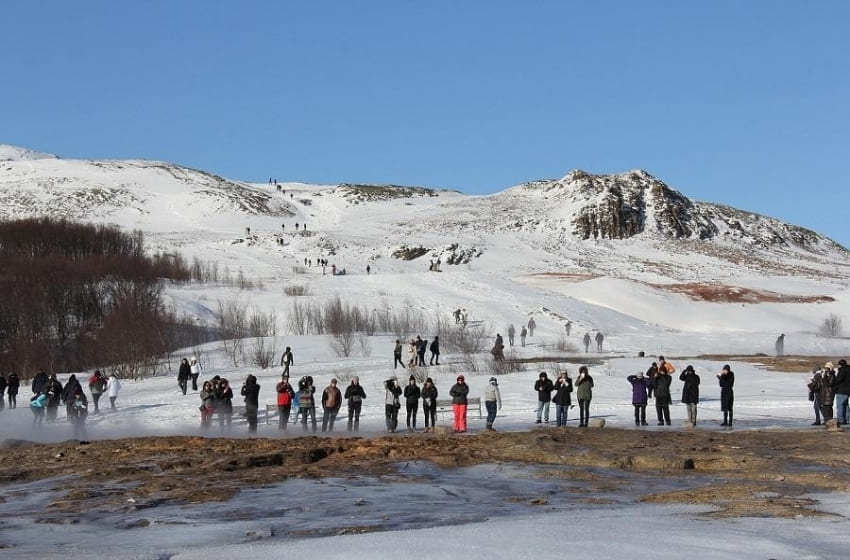
Attire and Gear
I know you already see yourself immersed in a warm natural stream. But before that, what should you pack? Dressing appropriately for this adventure is akin to choosing your armor for an enchanting quest. Layering is essential to adapt to Iceland’s changeable weather. Start with moisture-wicking base layers to stay dry, add insulating layers for warmth, and do a windproof and waterproof outer layer to protect against the elements.
Resistant, waterproof hiking boots with ankle support are a must for your feet, accompanied by warm socks. A wide-brimmed hat and sunglasses offer protection, while a well-equipped waterproof backpack carries essential supplies like water, snacks, and a camera to capture the moments that define your Reykjadalur hike experience. In essence, your attire and gear become tools to connect with nature, ensuring your journey is as comfortable as it is transformative.
Hot Springs and Bathing
At the geothermal wonderland of Reykjadalur, the Earth’s energy takes center stage. Here, you’ll encounter bubbling hot springs, hissing fumaroles, and a warm river like no other. Discover the delightful temperature variations in the river and the essential guidelines for a safe and respectful soak. But remember, in this pristine sanctuary, conservation is key. Hot spring bathing is not just for mere relaxation. It comes with great health advantages:
- Pain Relief: The natural minerals found in hot spring water, such as sulfur, silica, and calcium, alleviate various types of pain, like arthritis, muscle soreness, and joint discomfort. The heat and buoyancy of the water also reduce the impact on joints, providing relief for those with chronic pain conditions.
- Improved Circulation: Hot spring bathing dilates blood vessels and enhances circulation, helping deliver oxygen and nutrients to tissues and promoting improved cardiovascular health.
- Skin Rejuvenation: The mineral-rich water in hot springs can improve skin health. The sulfur content, for instance, may help with conditions like psoriasis, eczema, and acne. The heat opens pores, allowing for deep cleansing and detoxification.
- Improved Metabolism: Hot spring bathing may boost metabolic activity, aiding in weight management and digestion.
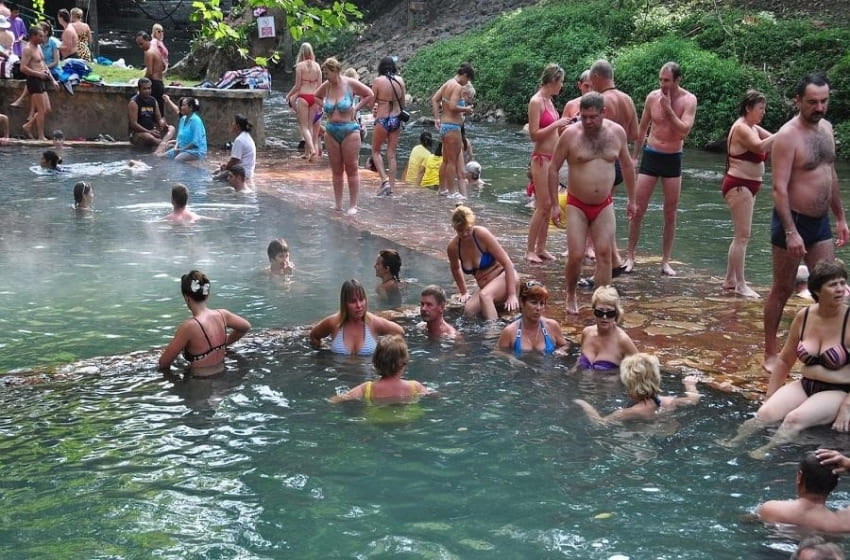
Description of the Geothermal Features in Reykjadalur
Reykjadalur unfolds as a geothermal wonderland, where Earth’s inner energy dances in the spotlight. As you enter this enchanting oasis, nature’s geothermal marvels greet you with a captivating show. Wisps of steam rise gracefully, crafting an ethereal atmosphere. The landscape is adorned with bubbling hot springs and murmuring fumaroles, vividly attesting to the Earth’s fiery heart. Reykjadalur’s geothermal theater isn’t just a visual spectacle but a living testament to the dynamic forces shaping our planet. Among the geothermal features you’ll find here are:
- Hot Springs: Reykjadalur’s Steam Valley really lives up to its name, with numerous hot springs scattered throughout the area. These hot springs range in temperature from pleasantly warm to near boiling and provide a relaxing soak amid nature’s beauty.
- Fumaroles: Hissing fumaroles are a common sight in Reykjadalur. These steam vents result from the interaction between groundwater and hot volcanic rocks beneath the Earth’s surface. Once they meet, they release clouds of steam and gases, creating an otherworldly atmosphere.
- Mud Pots: Mud pots, or mud pools, are geothermal features where boiling mud bubbles and churns. These fascinating natural phenomena appear when hot water interacts with volcanic ash and minerals, creating a thick, bubbling mud.
- Sulfur Deposits: Everyone knows Reykjadalur for its sulfur deposits, which manifest as yellow-stained rocks and ground. The distinctive sulfur smell is often present in the air due to the geothermal activity.
- Geothermal River: One of Reykjadalur’s highlights is the warm river that runs through the valley. The river’s temperature varies at different points, offering bathers a range of options, from hot to comfortably warm sections. The warm water flows from geothermal springs upstream.
Temperature Variations in the River
The heart of Reykjadalur is its warm river, where you can immerse yourself in therapeutic waters. What makes this experience truly unique is the river’s temperature variations. That is, you’ll discover pockets of warmth and cooler areas as you wade in.
Some parts of the river are soothingly hot, while others offer a refreshing contrast. It’s like nature’s own jacuzzi with customizable settings. The water’s temperature is a reminder of the dynamic forces beneath the Earth’s surface, creating a spa-like experience in the heart of the wilderness.
If you plan to soak, anywhere along the boardwalk is a safe zone. But to ensure safety, I suggest you dip with your feet first instead of plopping your whole body in, in case the temperatures are too high. While the boardwalk waters remain at 104 degrees in May through September, the temperatures drop to lukewarm by winter.
Guidelines for Safe and Respectful Bathing
To fully enjoy the hot springs in Reykjadalur, it’s essential to follow guidelines that ensure your safety and preserve this precious natural resource. The key to a rewarding soak is to test the water’s temperature before fully immersing yourself. Remember, the hot springs vary in heat, so exercise caution. Additionally, it’s important to wear bathing suits, as nudity is generally not allowed in this public setting.
Reykjadalur is a pristine environment, and it’s our collective responsibility to keep it that way. Therefore, always pack out what you bring in, avoid digging or altering the pools, and refrain from using soap or shampoo, as they can harm the fragile ecosystem.
Reykjadalur Hot Springs area is very basic as there are no traditional changing rooms. So, where do you get the cover to change to hiking and soaking gear? There are elevated open changing screens that can shield you from wind and curious eyes. But I believe no one who gives a damn. Some will change into bathing costumes from the car while others do it by the river.
Importance of Environmental Conservation
Reykjadalur’s beauty is inseparable from its delicate ecosystem. As you revel in the geothermal oasis, remember the profound importance of environmental conservation. Leave no trace of your visit, respecting the natural world around you.
By treading lightly, you’re not only preserving this enchanting destination for future generations but also contributing to the harmonious coexistence of nature and human exploration. Reykjadalur is not just a destination; it’s a sanctuary where the energy of the Earth invites us to connect, rejuvenate, and embrace the healing power of geothermal waters.
When Is the Best Time to Visit Reykjadalur Hot Springs
When it comes to visiting Reykjadalur Valley, timing can be the key to a truly unforgettable experience. We’ll weigh the pros and cons of each season, helping you make an informed choice for your adventure. Moreover, we’ll check the factors to consider when deciding the timing of your visit, ensuring that every moment in Reykjadalur stays in your mind for years to come.
1) Summer (June to August)
- Pros: Long daylight hours, lush green landscapes, easier hiking conditions, and a chance to witness Iceland’s unique flora and fauna.
- Cons: Crowds of tourists, especially during the peak summer months.
2) Winter (December to February)
- Pros: Solitude and tranquility, stunning snowy landscapes, the opportunity to see the northern lights, and the magical contrast of hot springs against the snowy surroundings.
- Cons: Short daylight hours, colder temperatures, and potentially challenging hiking conditions.
3) Shoulder Seasons (Spring and Autumn)
- Pros: Fewer tourists, pleasant weather, and changing colors of the valley.
- Cons: Less predictability in weather conditions compared to summer, and you might miss the extreme contrasts of winter.
Ultimately, the best time to visit Reykjadalur depends on your preferences. Summer might be ideal if you prefer milder weather and longer daylight hours. Winter can be magical for those seeking a more serene and potentially snowy experience. Shoulder seasons offer a balance between fewer crowds and decent weather.
Consider what type of experience you’re looking for, your tolerance for different weather conditions, and whether you want to witness specific natural phenomena like the northern lights. Reykjadalur’s beauty is something you can enjoy year-round; it’s just a matter of aligning your visit with your personal preferences and interests.
After a Long Hike, Where Can You Rest Around Reykjadalur?
The Reykjadalur Valley is in the proximity of Hveragerði or Selfoss, but they’re not the only available options. If you tour the valley on a day trip, it only makes sense to get accommodation around. Some popular places to stay include:
- Frost and Fire Hotel: A boutique hotel known for its geothermal baths and picturesque location.
- Hveragerði Cottages: Cozy cottages offering a comfortable stay near the town center.
- Hotel Örk: A well-established hotel with various amenities and dining options. It lies approximately 600m from the Reykjadalur Hot Springs trailhead.

Wrap-Up: Ready to Visit Reykjadalur?
Reykjadalur is a natural geothermal marvel that invites you to hike through breathtaking landscapes, soak in warm river waters, and connect with Earth’s inner energy. It’s one of the most unique destinations in Iceland that you must visit no matter what. As you embark on your adventure, I encourage you to explore this beautiful geothermal zone with a deep sense of respect for its natural beauty and environment. Practice responsible tourism, leave no trace, and preserve Reykjadalur for future generations to enjoy.

